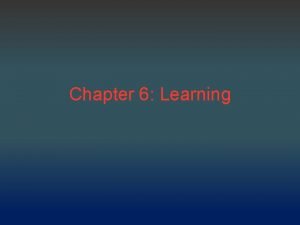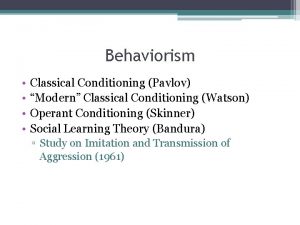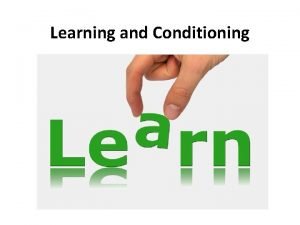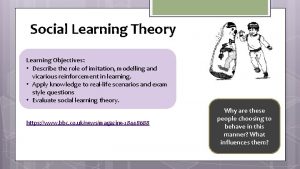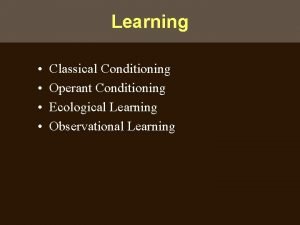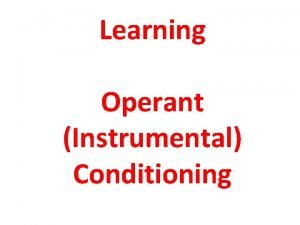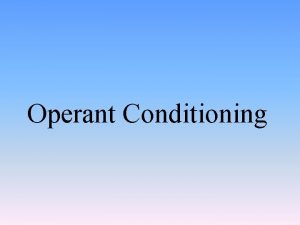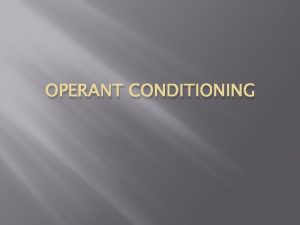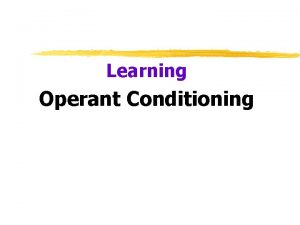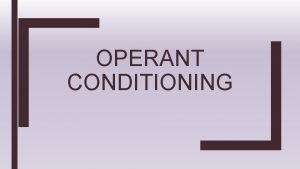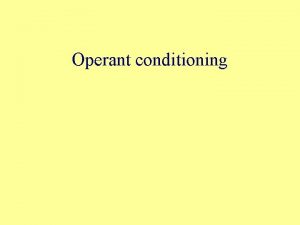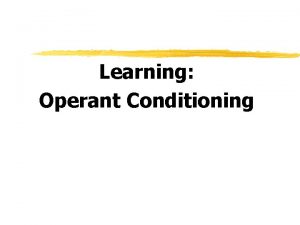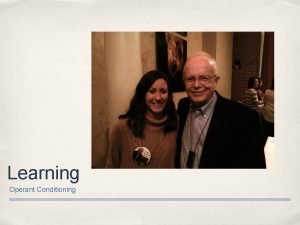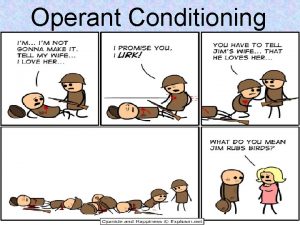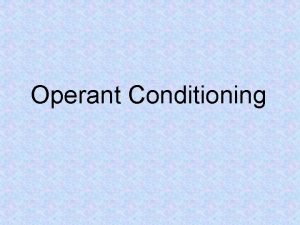Operant Conditioning Operant Conditioning Learning when an animal













- Slides: 13

Operant Conditioning

Operant Conditioning • Learning when an animal or human performs a behavior, and the following consequence increases or decreases the chance that the behavior will happen again • B. F. Skinner • Skinner box

Operant Conditioning • Shaping – Procedure in which an experimenter successively reinforces behaviors that lead up to or approximate the desired behavior – Rat progressively gets reinforced until it is actually pressing the bar in order for it to get food

Operant Conditioning • Consequences – Reinforcement • A consequence that occurs after a behavior and increases the chance that the behavior will happen again – Punishment • A consequence that occurs after a behavior and decreases the chance that the behavior will happen again

Operant Conditioning • Reinforcement – Positive Reinforcement • Refers to the presentation of a stimulus that increases the probability that a behavior will occur again • Positive reinforcer- stimulus that increases the likelihood that a response will occur again

Operant Conditioning • Negative reinforcement – Refers to an aversive stimulus whose removal increases the likelihood that the preceding response will occur again • Primary reinforcers- a stimulus that is innately satisfying and requires no learning to become pleasurable • Secondary reinforcer- stimulus that has required its reinforcing power through experience

Operant Conditioning • Punishment – Positive Punishment • Presenting an aversive stimulus after a response – Negative Punishment • Removing a reinforcing stimulus after a response

Operant Conditioning • Schedule of Reinforcement – Continuous reinforcement • Every occurrence of the operant response results in delivery of the reinforcer – Partial reinforcement • Situation in which responding occurs only some of the time •

Operant Conditioning • Partial Reinforcement schedules – Fixed-ratio Schedule- reinforcer occurs only after a fixed number of responses – Variable-ratio schedule- reinforcer is delivered after an average number of responses – Fixed-interval schedule- reinforcer occurs following the first response that occurs after a fixed interval of time – Variable-interval Schedule- reinforcer occurs following the first correct response after an average amount of time has passed

Cognitive Learning • Social Cognitive Learning- results from watching, imitating, and modeling; does not require the observer to perform any observable behaviors or receive any observable reward • Alfred Bandura • Bobo Doll experiment

Cognitive Learning • Learning vs. performance – Learning may occur, but may not always be measured by, or immediately evident in, performance

Cognitive Learning • Four processes – Attention • Observer must pay attention to what the model says or does – Memory • Observer must store or remember the information so that it can be retrieved later

Cognitive Learning • Imitation – Observer must be able to use the remembered information to guide their own actions to imitate the models behavior • Motivation – Observer must have some reason or incentive to imitate the model’s behavior
 Operant vs classical conditioning
Operant vs classical conditioning Albert experiment
Albert experiment Tolmans rat experiment
Tolmans rat experiment Operant conditioning
Operant conditioning What is classical conditioning example
What is classical conditioning example Classical vs operant conditioning
Classical vs operant conditioning Classical vs operant conditioning
Classical vs operant conditioning Difference between operant and classical conditioning
Difference between operant and classical conditioning Classical conditioning vs operant conditioning
Classical conditioning vs operant conditioning Operant conditioning classical conditioning
Operant conditioning classical conditioning Social learning objectives
Social learning objectives Partial reinforcement
Partial reinforcement Observational learning classical and operant conditioning
Observational learning classical and operant conditioning Operant conditioning
Operant conditioning







